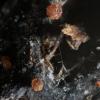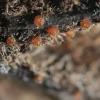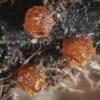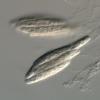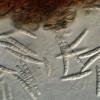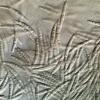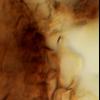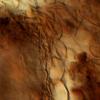
09-11-2025 13:20
Hello.A tiny ascomycete, appearing as erupting gra

08-11-2025 00:29
 Francois Guay
Francois Guay
I found this species in Quebec, Canada, on herbace

04-11-2025 09:07
Hello.A suspected Hymenoscyphus sprouting on a thi

04-11-2025 12:43
 Edvin Johannesen
Edvin Johannesen
Hi! One more found on old Populus tremula log in O

03-11-2025 21:34
 Edvin Johannesen
Edvin Johannesen
These tiny (0.4-0.5 mm diam.), whitish, short-stip
Calonectria pyrochroa ?
Chris Yeates,
07-09-2013 21:00
 Bonsoir tous
Bonsoir tousWhile searching for aero-aquatic fungi in a boggy/muddy area in woodland recently I found an Acer pseudoplatanus leaf which had, running along the leaf-veins of the underside, good material of a Nectria-like pyrenomycete.
Working through Rossman's Mycol Pap. no. 150 "The Phragmosporous Species of Nectria . . . " has led me to suspect that this is Calonectria pyrochroa on the following grounds:
* habitat on the underside of a fallen rotting leaf
* orange coloured perithecia covered by warts/loose globose bodies; not collapsing on drying
* no stroma
* perithecial wall apparently of two layers (how some of you guys cut those beautiful sections I don't know! it's beyond me . . .)
* ascospores clustered/fasciculate in the asci
* ascospores long, curved, fusoid, all 3-septate when mounted in lactophenol
* ascospore dimensions 57-90 x 9-10.8µm (this is slightly larger than what appears in the literature - spores measured living and in water)
there were certainly Cylindrocarpon type conidia around, but there were also other anamorphic fungi present and it was hard to be certain of associations.
Any comments or suggestions gratefully received
amitiés
Chris
Christian Lechat,
10-09-2013 06:20

Re : Calonectria pyrochroa ?
Hi Chris,
could you please specify the size of ascospores?
Regards,
Christian
could you please specify the size of ascospores?
Regards,
Christian
Chris Yeates,
10-09-2013 17:02

Re : Calonectria pyrochroa ?
apologies Christian
I realise that the measurements I gave before are incorrect (they were for a different microscope/camera combination) - and then a typing error! :(
the spore measurements should be 41.3-55.4 x 6.2-8µm (which fits better for C. pyrochroa)
I realise that the measurements I gave before are incorrect (they were for a different microscope/camera combination) - and then a typing error! :(
the spore measurements should be 41.3-55.4 x 6.2-8µm (which fits better for C. pyrochroa)
cordialement
Chris
Christian Lechat,
11-09-2013 08:03

Re : Calonectria pyrochroa ?
I'm surprised, if the ascospores measure 41.3-55.4 x 6.2-8 µm, that does not fit very well for C. pyrochroa, the ascospores of C. pyrochroa measure 40-80 (-100) x 4-8.5 µm. Are you sure of your measurements?
Christian
Christian
Chris Yeates,
13-10-2013 17:14

Re : Calonectria pyrochroa ?
Thanks for your suggestions, Christian.
Revisiting this, I have re-measured the spores from all the photographs I took of them, fresh, alive and in water. I get 41.2-63.3 x 6-7.2µm.
I have since become aware of Key to Tropical Species of Nectria-like Fungi
G.J. Samuels, A.Y. Rossman & H.-J. Schroers in Tropical Mycology, Volume 2, Micromycetes (CABI , 2002); here the relevant entry reads:
"Perithecia red to dark red; ascospores 40–70 x 4–7 µm, smooth, 1–3-septate; anamorph Cylindrocladium ilicicola....... Calonectria pyrochroa (Desm.) Sacc. (Rossman et al., 1999)"
This implies that Rossman et al. have revised the size range downwards, and I am now happier with my suggested determination, as habitat, perithecial structure, spore shape and septation all fit as well.
amitiés
Chris
Revisiting this, I have re-measured the spores from all the photographs I took of them, fresh, alive and in water. I get 41.2-63.3 x 6-7.2µm.
I have since become aware of Key to Tropical Species of Nectria-like Fungi
G.J. Samuels, A.Y. Rossman & H.-J. Schroers in Tropical Mycology, Volume 2, Micromycetes (CABI , 2002); here the relevant entry reads:
"Perithecia red to dark red; ascospores 40–70 x 4–7 µm, smooth, 1–3-septate; anamorph Cylindrocladium ilicicola....... Calonectria pyrochroa (Desm.) Sacc. (Rossman et al., 1999)"
This implies that Rossman et al. have revised the size range downwards, and I am now happier with my suggested determination, as habitat, perithecial structure, spore shape and septation all fit as well.
amitiés
Chris

